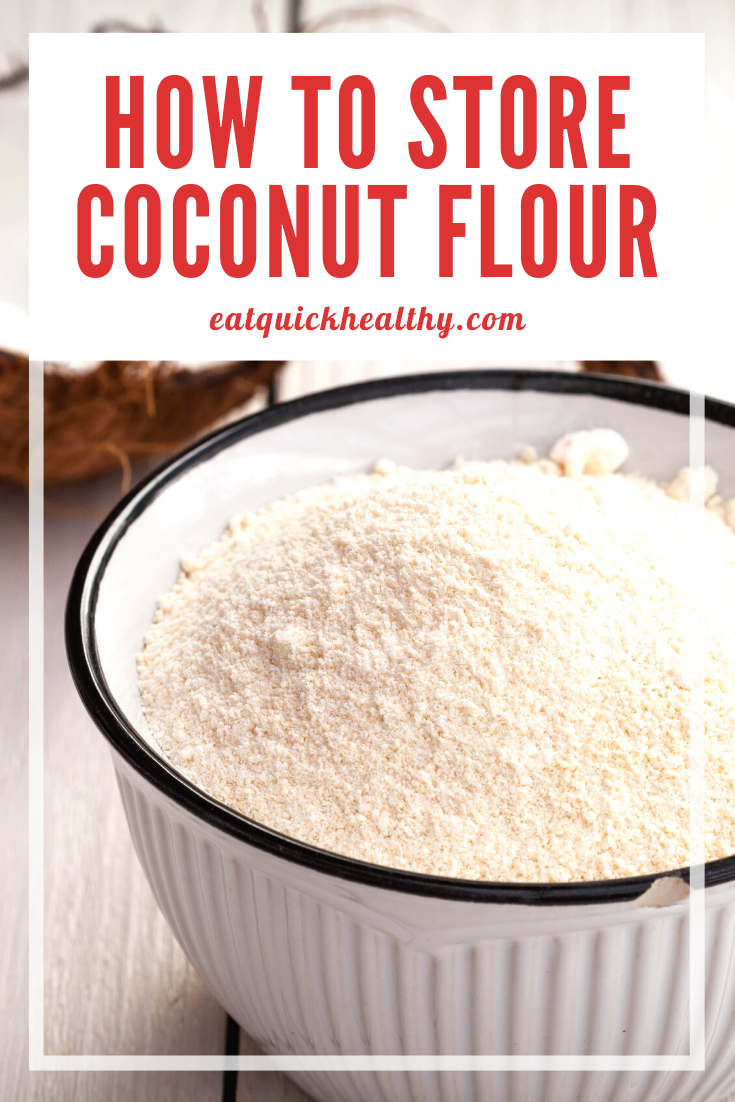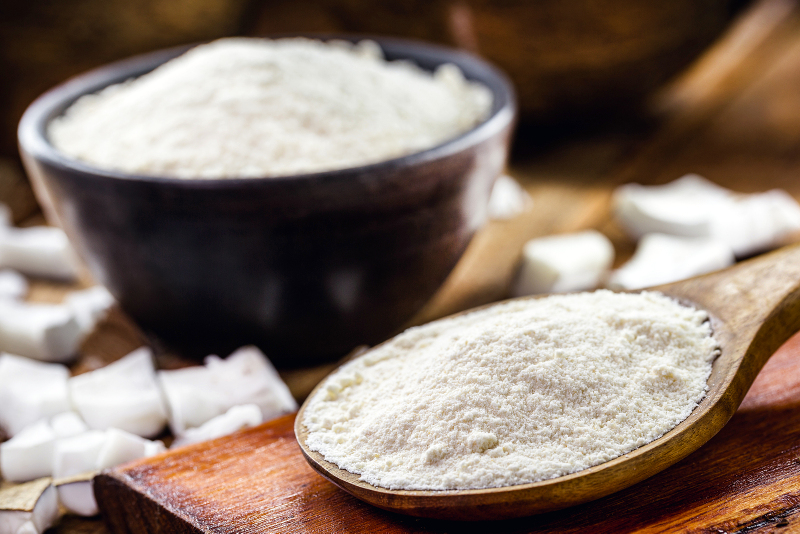Did you just buy a bag of coconut flour but you don’t know what to do with it now that you’ve opened it? No worries! We’ll teach you how to store coconut flour to ensure that it lasts as long as possible.
This guide also covers other things like what coconut flour is, whether or not it can go bad, how to check if it has gone bad, coconut flour’s shelf life, and of course, the different ways to store it.
Coconut flour is a great baking ingredient to keep in your kitchen, and by knowing more about it, you can utilize it to its maximum potential! So, keep reading to find out what you need to know about this fantastic coconut flour.

What Is Coconut Flour?
Coconut flour is a popular baking flour that is derived from a coconut palm plant and made from dried coconut meat. Coconut milk is extracted from the coconut meat and then the meat is ground. Once it’s ground, you have coconut flour!
The flour is a lot like wheat flour in terms of color. They both come in a white or off-white color. Coconut flour is popular among those who are on a gluten-free diet or suffer from celiac disease because it doesn’t have, you guessed it, gluten.
For 100 grams of coconut flour, you should expect it to have around 18 grams of protein, 12 grams of fat, and 16 grams of carbohydrates. It’s very high in fiber, around 45 grams per 100 grams of flour. As you likely know, fiber is very important as it has several health benefits, including aiding in digestion, regulating blood sugar levels, and lowering cholesterol levels.
An important thing to remember, however, is that if you’re not used to consuming a high amount of fiber, coconut flour may induce bloating. You can use coconut flour to bake several tasty goods, including bread, cookies, muffins, and cakes.

Does Coconut Flour Go Bad?
For storing coconut flour, it’s key to know if coconut flour will go bad or not. If it doesn’t go bad, then storing it properly will have fewer implications. However, coconut flour does go bad. And that’s why it’s important to know how to store the flour correctly in your kitchen to maximize its shelf life.
The coconut flour will come in a package that will keep it while it’s unopened. And once it has been opened, placing the flour in its original bag inside a resealable bag is the best practice.
How To Tell If Coconut Flour Is Bad
Knowing how to tell if coconut flour has gone bad is an important thing to understand, and in this section, we’ll walk you through exactly how to do that. Now, coconut flour will have a “best-before date” on its packaging, but remember, that date is typically a guideline and will not necessarily properly reflect how long your coconut flour will last.
There are different ways to tell if your coconut flour has gone bad. Here are the best ways to do it:
- Look at it: If the coconut flour looks extremely clumpy, it’s likely gone bad. There can be a few clumps. That’s natural.
- Smell it: Performing a smell test is a tried and true method for testing food products. And that’s no different with determining if your coconut flour is still good. Open the packaging and smell the flour, and if it smells off, you should discard it.
- Taste it: Another method you can use to check to see if your coconut flour has gone by is by tasting it. If it tastes bitter, then you know it’s time to throw it out and head to the grocery store to buy more.
Can You Freeze Coconut Flour?
Freezing coconut flour is something you can do, especially if you want to extend its shelf life. Just like with all food products, make sure you seal the flour as best as you can and then place it in your freezer. It’s that easy!
How To Store Coconut Flour
There are three main ways that you can store coconut flour. And whether or not it’s been opened, you can use all three of these methods to keep the flour in your home. Of course, when coconut flour has been opened, its shelf life will change. However, we will teach you how to correctly store coconut flour so you can keep it as long as possible.
Here are the three ways to store your coconut flour:
You Can Keep Coconut Flour in a Pantry
One of the most popular ways to store coconut flour, especially if it’s unopened, is to keep it in a pantry. A pantry is a cool, dark storage spot that is typically away from any direct heat source, making it an ideal place for coconut flour.
If you have opened the coconut flour, make sure it’s sealed well before placing it back in the pantry.
The Fridge Is Another Great Option for Storing Coconut Flour
Another great spot to store your coconut flour is the fridge. It can stay in there before you open it and after you’ve used it, and by living in a fridge, it will have a longer shelf life than if it resided in a pantry.
Make sure you’ve sealed it properly and place it in the fridge, if you have room, of course!
To Maximize Its Life, Coconut Flour Can Live in the Freezer
The best way to ensure that your coconut flour will have a long life is by keeping it in the freezer. Just like the pantry and fridge options, you can keep the flour in the freezer regardless of whether it has been opened or not.
Just like both previous options, ensure it’s been sealed fully and place it in the freezer.
How To Freeze Coconut Flour
Properly freezing coconut flour comes down to storing it appropriately. Here we’ll go through how to freeze opened and unopened coconut flour. Freezing coconut flour is a critical thing to do if you’ve found yourself with a lot of it and don’t plan on using it all any time soon.
Here’s what to do:
Freezing Unopened Coconut Flour
When you go to the grocery store and buy coconut flour, it’ll probably come in a plastic bag or cardboard container. And if that’s the case, then you’ll be fine to just place it into the freezer as is. And you’re done!
Freezing Opened Coconut Flour
Once you’ve opened the coconut flour, you can keep it in its original packaging. However, you’ll have to add one extra step. To freeze opened coconut flour properly, place the opened package in a resealable bag. That will ensure that the flour is fully protected. Then, you can put it into the freezer and keep it there until the next time you plan on baking.
What Is The Shelf Life Of Coconut Flour?
You can use coconut flour past its best-before date, granted that you’ve checked to see if it has gone bad or not. And we taught you how to do that in an earlier section of this blog. Coconut flour’s shelf life will be determined by how it’s stored and whether its package has been opened or not.
If it’s unopened and you have the coconut flour in your pantry, it’ll stay useable between three to six months past its best-before date. If it’s in the fridge, you’ll double its life expectancy to six to 12 months past the best-before date. And if you keep your unopened coconut flour in the freezer, it’ll have a whopping shelf life of one to two years.
But, you’ve bought coconut flour to use it, right? So chances are you’re more curious about coconut flour’s shelf life once it has been opened.
If you’re storing it in your pantry, the product’s best-before date is a good measure to go by. Once the date has been exceeded, make sure you do your gone-bad check whenever you go to use the coconut flour.
If you choose to store your opened coconut flour in the fridge, then it’ll typically last three to six months past its best-before date. And if it’s kept in the freezer, you can expect to add six months to a year to the flour’s best-by date.
| The coconut flour is… | It is stored in the… | It will last for… |
| Unopened | Pantry | Best-before date + 3-6 months |
| Fridge | Best-before date + 6-12 months | |
| Freezer | Best-before date + 1-2 years | |
| Opened | Pantry | Best-before date |
| Fridge | Best-before date + 3-6 months | |
| Freezer | Best-before date + 6-12 months |
FAQs
Should I sift coconut flour before storing it?
Coconut flour tends to clump over time due to its high fiber content. While sifting is not necessary before storing, it can help break up any existing clumps. If you prefer, you can sift the flour before transferring it to an airtight container.
What is the ideal storage temperature for coconut flour?
Coconut flour should be stored in a cool, dry place. The ideal storage temperature for coconut flour is below 75°F (24°C). Avoid exposing it to direct sunlight or heat sources, as it can affect its quality.
How should I defrost frozen coconut flour before using it?
When you want to use frozen coconut flour, simply remove the desired amount from the freezer and let it thaw at room temperature. Avoid thawing and refreezing coconut flour repeatedly, as it can affect its quality and texture.
Conclusion
Coconut flour is a great baking ingredient for you to consider, especially if you’re on a gluten-free diet or suffer from celiac disease. It’ll give you a big boost of protein and fiber, and it’s just as easy to bake with as other flours on the market.
As we’ve laid out in this blog, it’s very easy to store coconut flour. It will go bad, so that’s why you need to store it correctly to extend its shelf life as much as possible. Whether you want to keep coconut flour in the pantry, the fridge, or the freezer, there are a ton of options for you to choose from.
The most important thing to remember is to ensure that your flour is sealed properly, and that may involve placing the original packaging in a resealable bag.
So, now that you know how to correctly store your coconut flour, there’s only one big thing left to do. Start baking!
Want to learn more? Click here to find all our coconut product guides. You can click here to learn how to store coconut cream or here for coconut milk.


Comments are closed.